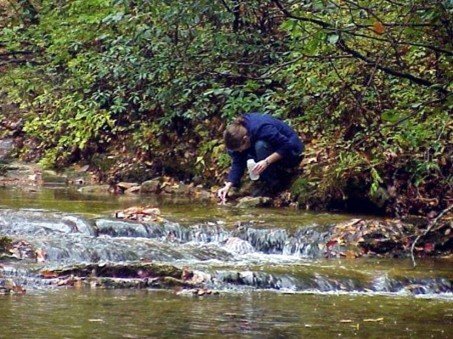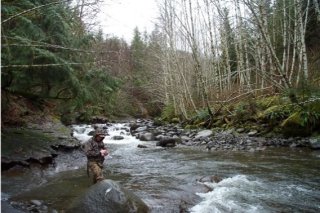Testing the Waters: EPA Researchers Study the Changing Nitrogen Landscape in Streams
Published June 25, 2024

Air quality regulations such as the Clean Air Act have led to improved air quality over the last several decades. One example of these improvements is the decline in nitrogen and sulfur atmospheric deposition across many areas of the United States.
Atmospheric deposition is a broad term that includes the transfer of materials from the atmosphere to the Earth’s surface. Acidic deposition (or acid rain) occurs when precipitation and particles with acidic components such as carbonic, sulfuric, or nitric acid fall to the ground from the atmosphere in wet or dry forms. Acid rain’s ecological effects can be clearly seen in aquatic environments, such as streams and lakes where they can be harmful to fish and other organisms. Since atmospheric deposition contains nitrogen, excessive deposition can acidify as well as cause an enrichment of the watershed’s nutrients, which can affect the water’s biological and chemical processes.
“We know that the Clean Air Act, especially the 1990 amendments, has caused substantial reductions in nitrogen deposition in many watersheds, especially in the eastern U.S.,” EPA researcher Jana Compton said. “Our question was, ‘Do we see improvements in water quality associated with the changes in nitrogen inputs from air sources?’”
To explore this question, a team of researchers including former Oak Ridge Institute for Science and Education (ORISE) post-doctoral fellow Jiajia Lin, EPA researchers Jana Compton, Robert Sabo, Ryan Hill, Marc Weber, J. Renée Brooks, Steve Paulsen and John Stoddard, and Alan Herlihy from Oregon State University, published “The changing nitrogen landscape of United States streams: Declining deposition and increasing organic nitrogen.” The paper explores the relationship between deposition and water chemistry in small streams in the eastern contiguous U.S., where atmospheric deposition is the major nitrogen source for the watersheds.

The researchers used National Rivers and Streams Assessment (NRSA) monitoring data from the National Aquatic Resource Survey to analyze stream chemistry; the series of surveys sampled thousands of streams across the contiguous U.S., from 2000 to 2014. For purposes of this study, target “streams” were identified as flowing waters that were wadeable, generally meaning one could walk through the current.
Then, the team used the National Nutrient Inventory, a set of databases that identify the potential types and sizes of nutrient pollution sources in a specific location, to determine where among these streams atmospheric deposition was the largest nitrogen input. The researchers conducted statistical analyses to examine how nitrogen inputs and water chemistry changed over time. Using the NRSA statistical approach for population estimates, the findings were extrapolated to different regions across the contiguous U.S.

The study’s results illustrate a complex story about the current nitrogen landscape in U.S streams and more research is needed to better understand the implications. In eastern U.S. watersheds, change analysis showed that atmospheric nitrogen deposition declined: a testament to the Clean Air Act’s impact. Researchers observed small and non-significant declines in nitrate in streams; however, dissolved organic carbon and total organic nitrogen increased. Organic carbon and nitrogen are produced in terrestrial and aquatic ecosystems and can be influenced by ecosystem productivity and soil properties. The changes in total organic nitrogen concentrations indicate an increase in the mobilization of organic nitrogen, or the amount of organic nitrogen that was released from the landscape and moved to the water. In addition, watershed organic nitrogen was exported at a faster pace than organic carbon. One “downstream” impact of increasing organic carbon and nitrogen is the need for added treatment and potential formation of disinfection byproducts in drinking water systems.
While streams in the eastern U.S. may be recovering from acidification due to reductions in acid deposition resulting from Clean Air Act amendments, the study signals that other biological or chemical processes may be impeding these improvements. Possible drivers behind these processes may include soil recovery from acidification, changes in carbon availability, or varying climate conditions in the watershed.
Now that the researchers discovered a pattern with increasing organic nitrogen, their findings set the foundation to continue monitoring these nutrient trends.
“We cannot really say with certainty what the cause is for these changes in stream nitrogen. What this paper does show is the strong and significant increase in organic nitrogen levels in these streams,” Compton said. “We found a widespread pattern and we need to better understand it to understand the possible outcomes and impacts.”
EPA researchers are working to compile data about nutrient inputs in water bodies to understand water quality and predict the impacts on watersheds from human activities.
Learn More About the Science
Basic Information on Nutrient Pollution
National Aquatic Resource Surveys
National Nutrient Inventory Portfolio
National Rivers and Streams Assessment
Nutrients and Harmful Algal Blooms Research
Tools and Resources Webinar: Nutrient Explorer (March 13, 2024)

